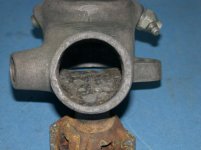iron_junkie
Aluminum
- Joined
- May 4, 2012
- Location
- Central New York
Hi all,
Have been using Evaporust during the restoration I'm working on and noticed that it seems to effect "cast iron", if you leave the part soaking in for at least 2 days. The rust comes off as advertised, but it seems that it takes pristine iron down with it. Surfaces that were rust free and machined smooth, end up looking very ruff, dull, and have an etched surface appearance. Anyone else notice this, and if so, what the maximum time limit you would leave a cast iron part soaking in this product?
On the other hand, steel (iron+carbon) parts seem to be unaffected. Only the rust comes off, and there is no change in surface finish on areas that were clean and rust free. Hardened steel seems to acquire a patina of sorts if you leave in it after a while, although I've only seen this once so far.
Cheers
Have been using Evaporust during the restoration I'm working on and noticed that it seems to effect "cast iron", if you leave the part soaking in for at least 2 days. The rust comes off as advertised, but it seems that it takes pristine iron down with it. Surfaces that were rust free and machined smooth, end up looking very ruff, dull, and have an etched surface appearance. Anyone else notice this, and if so, what the maximum time limit you would leave a cast iron part soaking in this product?
On the other hand, steel (iron+carbon) parts seem to be unaffected. Only the rust comes off, and there is no change in surface finish on areas that were clean and rust free. Hardened steel seems to acquire a patina of sorts if you leave in it after a while, although I've only seen this once so far.
Cheers



